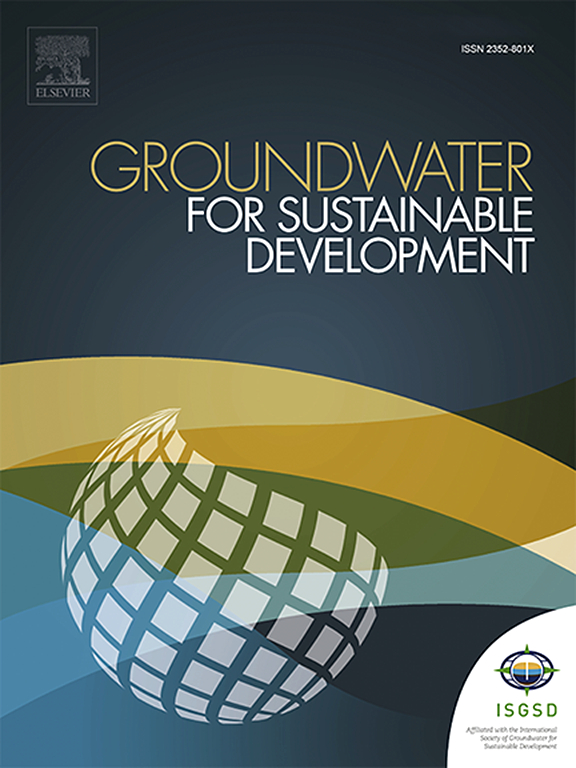Delimitation of potential zones for groundwater recharge and discharge in the Guayalejo–Tamesi River Basin, southern Tamaulipas, Mexico
IF 4.9
Q2 ENGINEERING, ENVIRONMENTAL
引用次数: 0
Abstract
The Guayalejo–Tamesi River Basin (GTB) has suffered from water scarcity mainly due to aquifer overexploitation, limited understanding of the surface water – groundwater relationship, and poor water resource management. Given this, appropriate land use can be a decisive factor in sustainable water management. In this context, the present study focuses on delineating potential groundwater recharge zones (PGRZ) and discharge zones (PGDZ) to achieve an overview of groundwater flow systems and thus preserve areas of hydrogeological importance. This analysis was conducted using a Geographic Information System (GIS), integrating satellite data, geophysical information, and terrain surface characteristics. Based on these databases, ten hydrogeological variables were obtained and assessed using an Analytical Hierarchy Process (AHP) based on Groundwater Flow System Theory (GFST) criteria. This resulted in two mathematical models estimating that 37.71 % and 11.78 % of the GTB exhibit PGRZ and PGDZ conditions, respectively. The models were validated by comparing the delineation of PGRZ and PGDZ with the locations of 222 springs and the chemistry of 30 groundwater samples, showing an accuracy of 75 % for the PGRZ calculation and 70 % for the PGDZ model. The model proved sufficiently accurate for identifying small PGRZ and PGDZ, thus providing a regional understanding of hydrogeological characteristics and groundwater flow dynamics at a local resolution.

墨西哥塔毛利帕斯州南部瓜亚莱霍-塔梅西河流域地下水补给和排放潜力区划分
瓜亚莱霍-塔梅西河流域(GTB)水资源短缺的主要原因是含水层过度开采、对地表水-地下水关系的认识有限以及水资源管理不善。鉴于此,适当的土地利用可以成为可持续水管理的一个决定性因素。在此背景下,本研究的重点是划定潜在的地下水补给区(PGRZ)和排泄区(PGDZ),以实现地下水流动系统的概述,从而保护水文地质重要性的地区。这项分析是利用地理信息系统(GIS)进行的,整合了卫星数据、地球物理信息和地形表面特征。在此基础上,采用基于地下水流系统理论(GFST)准则的层次分析法(AHP)对10个水文地质变量进行了评价。这导致两个数学模型分别估计37.71%和11.78%的GTB具有PGRZ和PGDZ条件。通过将PGRZ和PGDZ的圈定与222个泉水的位置和30个地下水样品的化学成分进行比较,验证了模型的准确性,结果表明PGRZ计算的准确性为75%,PGDZ模型的准确性为70%。该模型在识别小的PGRZ和PGDZ方面证明了足够的准确性,从而在局部分辨率上提供了对水文地质特征和地下水流动动力学的区域理解。
本文章由计算机程序翻译,如有差异,请以英文原文为准。
求助全文
约1分钟内获得全文
求助全文
来源期刊

Groundwater for Sustainable Development
Social Sciences-Geography, Planning and Development
CiteScore
11.50
自引率
10.20%
发文量
152
期刊介绍:
Groundwater for Sustainable Development is directed to different stakeholders and professionals, including government and non-governmental organizations, international funding agencies, universities, public water institutions, public health and other public/private sector professionals, and other relevant institutions. It is aimed at professionals, academics and students in the fields of disciplines such as: groundwater and its connection to surface hydrology and environment, soil sciences, engineering, ecology, microbiology, atmospheric sciences, analytical chemistry, hydro-engineering, water technology, environmental ethics, economics, public health, policy, as well as social sciences, legal disciplines, or any other area connected with water issues. The objectives of this journal are to facilitate: • The improvement of effective and sustainable management of water resources across the globe. • The improvement of human access to groundwater resources in adequate quantity and good quality. • The meeting of the increasing demand for drinking and irrigation water needed for food security to contribute to a social and economically sound human development. • The creation of a global inter- and multidisciplinary platform and forum to improve our understanding of groundwater resources and to advocate their effective and sustainable management and protection against contamination. • Interdisciplinary information exchange and to stimulate scientific research in the fields of groundwater related sciences and social and health sciences required to achieve the United Nations Millennium Development Goals for sustainable development.
 求助内容:
求助内容: 应助结果提醒方式:
应助结果提醒方式:


